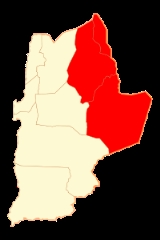
El Loa Province
Encyclopedia
El Loa Province is one of three provinces
of the northern Chile
an region of Antofagasta
(II). It is named after the longest of rivers in Chile, the Loa River
. The provincial capital is Calama
.
(INE), the province spans an area of 41999.6 sqkm and had a population of 143,689 inhabitants (73,970 men and 69,719 women), giving it a population density of 3.4 PD/sqkm. It is the sixth largest province in the country. Between the 1992 and 2002 censuses, the population grew by 14.9% (18,610 persons).
Provinces of Chile
A province is the second largest administrative division in Chile, after a region. Each region is divided into provinces. There are 54 provinces in total....
of the northern Chile
Chile
Chile ,officially the Republic of Chile , is a country in South America occupying a long, narrow coastal strip between the Andes mountains to the east and the Pacific Ocean to the west. It borders Peru to the north, Bolivia to the northeast, Argentina to the east, and the Drake Passage in the far...
an region of Antofagasta
Antofagasta Region
The II Antofagasta Region is one of Chile's fifteen first-order administrative divisions. It comprises three provinces, Antofagasta, El Loa and Tocopilla...
(II). It is named after the longest of rivers in Chile, the Loa River
Loa River
The Loa River is a U-shaped river in Chile's northern Antofagasta Region. At 440 km long it is the country's longest river and the main watercourse in the Atacama Desert.-Course:...
. The provincial capital is Calama
Calama, Chile
Calama is a city and commune in the Atacama Desert in northern Chile. It is the capital of El Loa Province, part of the Antofagasta Region. Calama is one of the driest cities in the world with average annual precipitation of just . The River Loa, Chile's longest, flows through the city...
.
Geography and demography
According to the 2002 census by the National Statistics InstituteNational Statistics Institute (Chile)
The National Statistics Institute of Chile is a state-run organization of the Government of Chile, created in the second half of the 19th century and tasked with performing a general census of population and housing, then collecting, producing and publishing official demographic statistics of...
(INE), the province spans an area of 41999.6 sqkm and had a population of 143,689 inhabitants (73,970 men and 69,719 women), giving it a population density of 3.4 PD/sqkm. It is the sixth largest province in the country. Between the 1992 and 2002 censuses, the population grew by 14.9% (18,610 persons).

